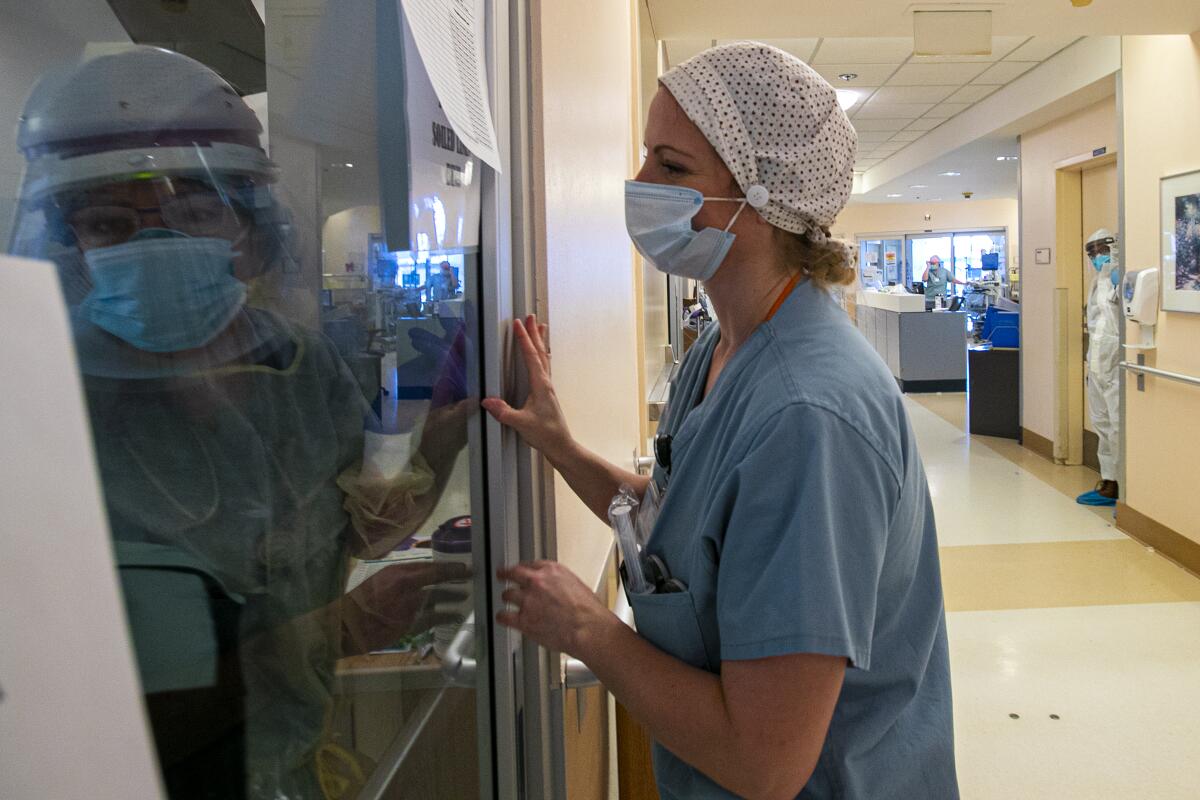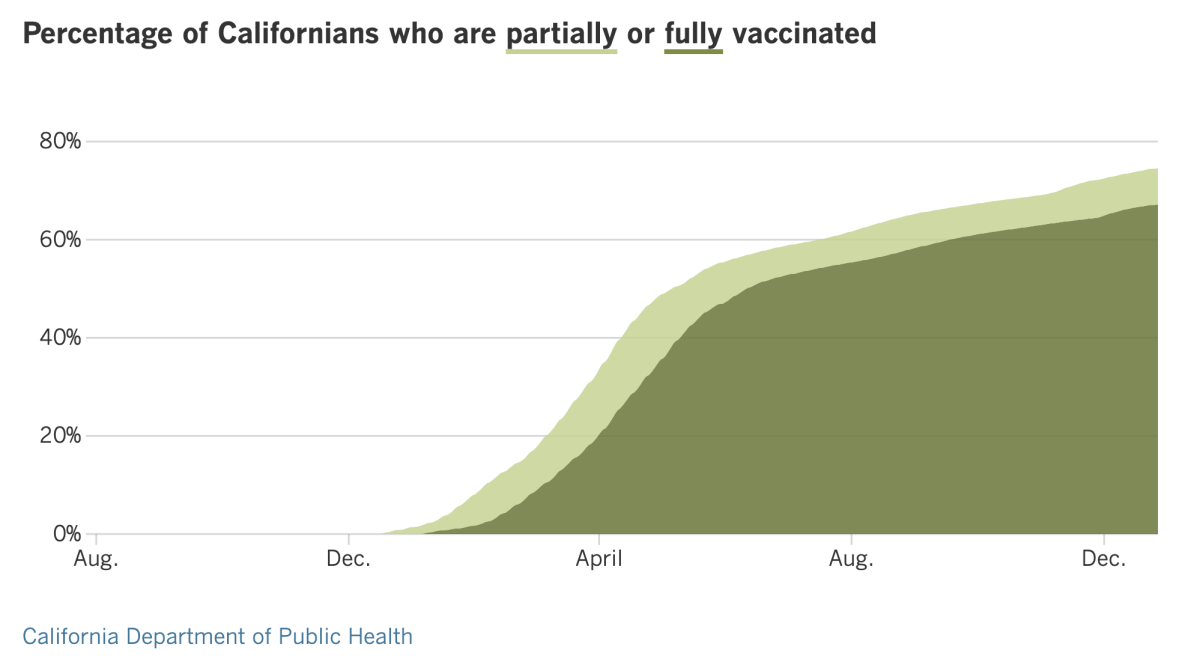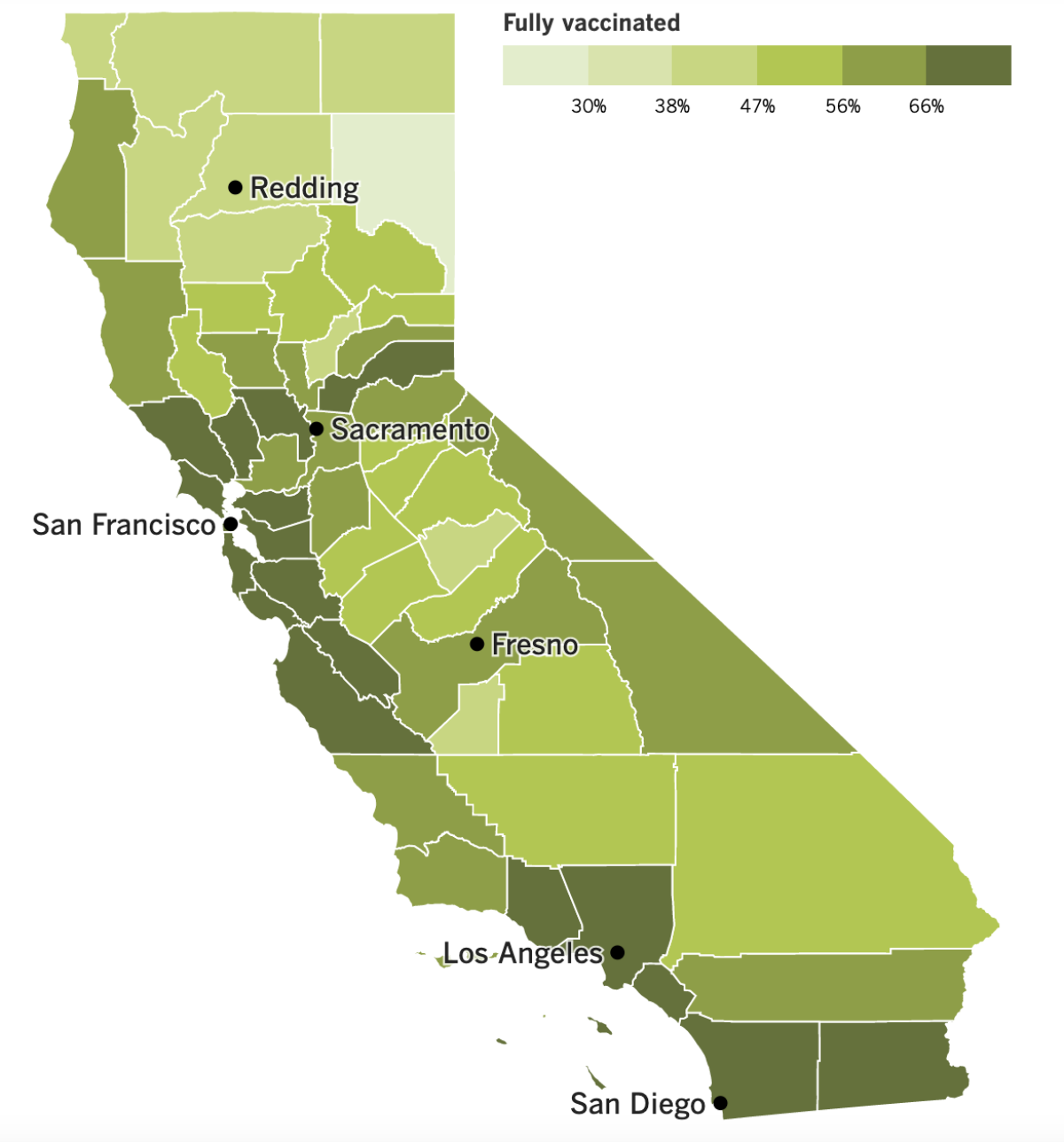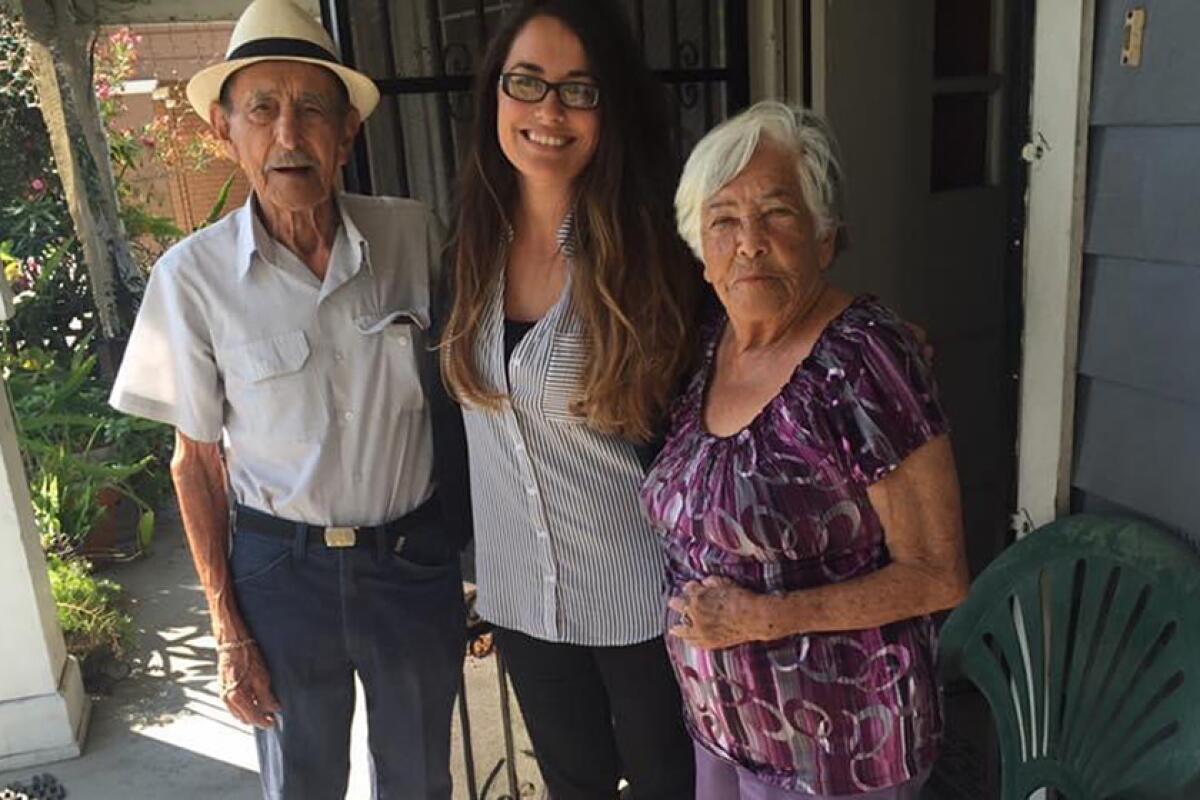Coronavirus Today: The missed opportunity of 2021
Good evening. I’m Karen Kaplan, and it’s Tuesday, Dec. 28. Since there’ll be no newsletter Friday, I’d like to take this opportunity to wish you all a happy — and healthy — new year. And now, here’s the latest on what’s happening with the coronavirus in California and beyond.
Oh what a difference a year makes.
This time last year, the United States was nearing the peak of the fall-and-winter surge that wound up killing more than 300,000 Americans. Hospitals were overflowing with COVID-19 patients, holiday celebrations were canceled, and an emerging coronavirus strain from the United Kingdom — later known as Alpha — prompted health officials to coin the term “variant of concern.”
Yet despite all this bleakness, there was hope that the pandemic had reached a turning point. That hope went by several names: Pfizer. Moderna. And soon, Johnson & Johnson.
Vaccines were supposed to turn the tide in the pandemic. Once a critical mass of the country — and the world — gained immunity from the shots, the coronavirus would struggle to find new hosts, and the global outbreak would sputter and die.
A year later, just 62% of Americans are fully vaccinated (even though everyone over the age of 4 is now eligible for the shots), according to the Centers for Disease Control and Prevention. And that’s well above the 46% mark for humanity as a whole, according to figures from the World Health Organization.
In the U.S., the consequences of this failure to take full advantage of vaccines can be seen in hospital wards that are once again filling with COVID-19 patients. My colleague Brittny Mejia visited Arrowhead Regional Medical Center in Colton last week and found nine such patients in the ICU, ranging in age from 26 to 66. None of them were vaccinated.
To be sure, the patient census is lower now than it was a year ago. But in a way, it’s worse, because these illnesses were preventable.
“It’s definitely frustrating,” said ICU charge nurse Beth Koelliker. “Patients are still dying at an alarming rate, all unvaccinated. They haven’t stopped dying for two years. It’s hard to deal with that for so long.”

That wasn’t what public health officials expected as 2021 got underway. In the early months of the year, the problem with COVID-19 vaccines was too little supply, not too little demand. Remember all those stories of privileged people who jumped the line to get shots before they were eligible, claiming doses that had been set aside for the disadvantaged and vulnerable?
A few months later, supply was up and demand was down. It seemed like health officials could barely give the doses away. Ohio Gov. Mike DeWine set up a lottery to offer $1-million prizes and college scholarships to those who were willing to get vaccinated. Other governors, including California’s Gavin Newsom, copied the idea.
President Biden set a goal of getting 70% of U.S. adults at least partially vaccinated by July 4. The country didn’t hit that mark until Aug. 2.
Partisanship was partly to blame. In a poll conducted this month by the Associated Press and NORC Center for Public Affairs Research, 93% of adults who identified as Democrats said they’d been vaccinated, compared with 74% of Republicans and 72% of independents. Perhaps more telling, 15% of Republicans and 12% of independents said they “definitely will not” get vaccinated, compared with 2% of Democrats.
Misinformation about the vaccines was another, often related, factor. Indeed, Vice President Kamala Harris recently told my colleague Noah Bierman that one of her biggest regrets was her failure to take vaccine misinformation more seriously and do more to counter it.
“The biggest threat still to the American people is the threat to the unvaccinated. And most people who believe in the efficacy of the vaccine and the seriousness of the virus have been vaccinated,” Harris said. “That troubles me deeply.”
Now there’s the added challenge of convincing millions of people who are eligible for booster shots to get them. There are huge gaps between the percentage of Americans who are fully vaccinated and the percentage who have gotten a booster, although it’s not clear from the CDC’s COVID Data Tracker how many fully vaccinated people are booster-eligible.
COVID-19 was a direct or contributing cause of an estimated 377,883 U.S. deaths in 2020. In 2021, a year in which vaccines are widely available, the death toll exceeded 440,000.
Over the weekend, my family streamed “Don’t Look Up” on Netflix. In the movie, Earth finds itself in the path of a comet that’s big enough to destroy the planet. But humanity is too busy squabbling over politics, swooning over high-tech gadgets and soaking up mindless TV to get its act together and save itself.
Director Adam McKay says the story is an “allegory for the climate crisis.” However, as I watched characters in the film shrug off scientists’ warnings time and time again, I couldn’t help thinking the story was actually about our response to the pandemic, especially with regard to vaccines.
“What do we have to say? What do we have to do?” asks exasperated astronomer Randall Mindy (played by Leonardo DiCaprio) after being ignored for the umpteenth time.
(Spoiler alert: Stop reading here if you don’t want to know how the movie ends.)
Later, when the comet is close enough to be visible in the night sky, some people are finally ready to listen — except by then, their fate is out of their hands. “We’ve been trying to tell you!” Mindy shouts as realization begins to dawn. “We’ve been trying to tell you this whole time!”
By the numbers
California cases and deaths as of 4:48 p.m. Thursday:

Track California’s coronavirus spread and vaccination efforts — including the latest numbers and how they break down — with our graphics.
How to handle your Omicron anxiety
Nearly every day brings another alarming headline about the Omicron variant. Since it’s still so new, we have more questions than answers about its capabilities. The resulting uncertainty is bound to make us feel anxious.
But that doesn’t mean you should feel helpless. In fact, there are concrete things you can do to keep your Omicron anxiety in check. Here’s a list to get you going, courtesy of my colleague Ada Tseng:
Don’t worry needlessly about threats that aren’t relevant to you.
The risk is not the same for everyone. Focus on case counts where you live instead of higher ones in another part of the country. If you’re vaccinated and got your booster shot, rest assured you’re less vulnerable than those who haven’t. (And if you haven’t gotten vaccinated or boosted, make plans to do so.) If you’re not planning to fly anywhere, there’s no need to fret about the risks of air travel. In short, take a breath and sort the real threats from the ones you don’t have to worry about.
Identify your emotional triggers.
If you notice that a certain Twitter feed or cable news show tends to send you into a spiral, close the app or turn off the TV. If it’s too difficult to wean yourself entirely, at least recognize the trigger exists. That should help you manage its power over your emotional state.
Tune into your body.
Got a headache? A sore jaw? Perhaps you’ve been clenching your teeth and not even realizing it. It may be a physical manifestation of your anxiety. The sooner you can tune into the signals your body sends you, the sooner you can work on addressing them.
The same goes for unhelpful thoughts, patterns and behaviors that can set off your anxiety like a runaway train. Try using cognitive behavioral therapy to identify these cycles so you can make a conscious effort to break them.
Focus on what you can change.
You didn’t have the power as an individual to keep the Omicron variant away. But you do have the power to reduce your risk of encountering it, and to make such encounters less dangerous. In addition to getting vaccinated and boosted, you can wear a high-quality mask, maintain physical distance, and ask people to get tested in advance of a gathering. If a situation makes you too uncomfortable, you have the power to stay home.
Cut yourself a little slack.
As Tseng reminds us, “You don’t feel bad because something is wrong with you. You feel bad because it’s been bad. You feel anxious because Omicron is anxiety-inducing.”
Your efforts to get that anxiety under control may not work right away, or every time. Don’t let that become another source of anxiety. Be kind to yourself, and remember that anxiety has a purpose: to grab our attention and motivate us to make changes if we’re in a perilous situation.
California’s vaccination progress


See the latest on California’s vaccination progress with our tracker.
Your support helps us deliver the news that matters most.
In other news ...
As expected, coronavirus cases are rising steeply in California and around the country. The number of new cases reported to the CDC hit 441,278 on Monday, by far the highest single-day total of the pandemic.
But that number is surely skewed by reporting delays over the holiday weekend. A more realistic measure is the seven-day moving average, which takes the total number of new cases over the past week and divides it by seven. According to the CDC, that figure for Monday was 240,408 — much lower than 441,278 but still higher than at any point during the Delta surge. In fact, the last time the seven-day moving average was this high was Jan. 13, just after the peak of the fall-and-winter surge. (In case you were wondering, the all-time high was 250,437 new cases on Jan. 11.)
New coronavirus cases in California have more than tripled over the last two weeks, according to The Times Tracker. Over the last seven days, the state has reported an average of 19,087 new infections per day, and Los Angeles County has averaged 8,418 new cases per day.
More concerning is the rise in hospitalizations. At least 4,378 patients with COVID-19 were being treated in California hospitals on Monday, and another 369 patients were suspected to have the disease. In L.A. County, the number of confirmed COVID-19 patients in hospitals is up 444% from two weeks ago; in Orange County, it’s up 257%; in San Diego, 165%; in Riverside, 94%; in San Bernardino, 75%; and in Ventura, 242%.
At the moment, it’s unclear how much of that increase is due to Omicron and how much is due to Delta. We know from the summer and early fall that Delta is capable of sending lots of people to the hospital. And now, with colder weather and holiday gatherings in the mix, Delta has more of an advantage than it did back then.
Omicron may pose less of risk for hospitalizations. A full picture of Omicron’s virulence is still emerging, but two studies released since our last newsletter reinforce this impression. In one, researchers from Imperial College London reported that in England, people infected with Omicron were 20% less likely to require hospital care and 40% less likely to be kept in a hospital overnight compared to people infected with Delta. In the other, scientists from the University of Edinburgh found the risk of hospitalization was as much as two-thirds lower with Omicron than with Delta.
L.A. County health officials are responding to the rising case numbers with expanded coronavirus testing services. Testing sites across the county are extending their hours of operation and adding more dates to their calendars. In addition, more mobile testing units are setting up shop in areas with the greatest demand.
The county health department also has fired up its free home test collection program. Residents who have COVID-19 symptoms or who think they’ve been exposed to someone who’s infected can go online to request a nasal test swab kit, which will be delivered within two days. Once the kit arrives, they must gather a sample and send it in right away. Results should be available within 48 hours.
With cases rising so quickly, some are wondering why the U.S. allows people to board airplanes without having to show proof of vaccination or a recent negative coronavirus test. California Sen. Dianne Feinstein and three members of the House of Representatives have asked the Biden administration to make this a requirement for domestic air travel, and Dr. Anthony Fauci said the idea was “something that seriously should be considered.”
Proof of vaccination or a negative test result is required for travelers from abroad, but Biden’s advisors say such measures aren’t necessary for domestic flights. A trade group representing the nation’s airlines said it agreed, while the Assn. of Flight Attendants said requiring proof of vaccination for domestic travelers “makes sense.” About 1 in 7 airline passengers are not vaccinated, according to a market research firm.
Speaking of leniency, the CDC eased up its isolation guidelines for people with coronavirus infections. The new recommendations say people who test positive should go into isolation for five days instead of the previously recommended 10. If a person has no COVID-19 symptoms at the end of those five days, they can return to normal activities as long as they wear a mask everywhere — including when they’re with others at home — for at least five more days. This advice applies to everyone, regardless of their vaccination or booster status.
The guidelines for quarantine were loosened too. Exposed individuals who are fully vaccinated and boosted can skip the quarantine if they wear a mask in all settings for at least 10 days. Everyone else should quarantine for five days; then, if they’re asymptomatic, they can resume normal activities as long as they wear a mask for another five days.
The CDC says the updated advice reflects growing evidence that infected people are most contagious two days before and three days after COVID-19 symptoms develop. Another factor is the recent surge in cases, since the old rules would have sidelined so many workers that hospitals, airlines and other businesses would have had trouble staying open.
Some scientists said the CDC’s move made sense; others called it “reckless.” And Marshall Hatch, senior pastor of New Mount Pilgrim Missionary Baptist Church on Chicago’s West Side, said the change was confusing and “a little incongruous.”
“Either we’re in a surge that we need to take very seriously or are we winding down the pandemic and that’s why we’re shortening the isolation and quarantine times,” he said. “They might want to give us a little more information to go with.”
Finally, the Food and Drug Administration has authorized two pills specifically designed to treat COVID-19. Both pills can be taken at home and promise a faster, cheaper way to treat early-stage cases. (All previously authorized treatments involved an IV or an injection.) Both pills should be effective against Omicron because they don’t target the spike protein, where most of the variant’s worrisome mutations reside.
Paxlovid, an antiviral from Pfizer, was authorized Wednesday, and Merck’s molnupiravir followed a day later. Experts expect the Pfizer drug to be the preferred pill because it was much more effective and produced milder side effects.
Your questions answered
Today’s question comes from readers who want to know: What makes the Omicron variant spread so quickly?
Omicron appears to have several advantages over previous variants.
For starters, it can replicate far faster than its predecessors. One preliminary study found that Omicron can copy itself in the bronchus — that’s the main airway into the lungs — 70 times faster than both the Delta variant and the original coronavirus strain.
That means people infected with Omicron can spew a lot more virus particles when they cough, sneeze or simply exhale, increasing the odds that someone standing close by will be infected and keep the outbreak going.
Researchers also suspect it means people who catch Omicron become contagious faster. If so, that would speed things up even more.
Other work has shown that Omicron is spreading more readily within households. That may be a sign that Omicron can get into the air more easily, and/or that less of it is needed to cause an infection.
Plus, evidence is mounting that the myriad mutations in Omicron’s spike protein make it easier for the variant to evade antibodies. If so, its ability to operate more freely inside a host’s body could be a factor in its increased transmissibility.
Researchers at the University of British Columbia in Canada have also found signs that Omicron’s mutations enable it to bond more strongly to the human cells it attacks. It’s likely that improves the variant’s ability to make copies of itself — and extra copies may mean extra spreading.
We want to hear from you. Email us your coronavirus questions, and we’ll do our best to answer them. Wondering if your question’s already been answered? Check out our archive here.
The pandemic in pictures

The woman with glasses is Times staff writer Brittny Mejia. In this photo, she is flanked by her grandfather Pablo Mariscal and her grandmother Maria Diaz. Both grandparents died of COVID-19 — Mariscal last fall and Diaz on Dec. 14.
Despite her fresh sorrow, Mejia has written a moving story about these and other deaths in her large extended family. One of the most painful aspects of her tale is the realization that some of these deaths could have been prevented by COVID-19 vaccines. But her family has been divided over the necessity of the shots. Some said they didn’t trust it; others insisted they didn’t need it.
There is one silver lining to her story: On the way to the cemetery for Diaz’s funeral, Mejia’s sister agreed to get vaccinated. Her appointment is scheduled for Friday.
Resources
Need a vaccine? Here’s where to go: City of Los Angeles | Los Angeles County | Kern County | Orange County | Riverside County | San Bernardino County | San Diego County | San Luis Obispo County | Santa Barbara County | Ventura County
Practice social distancing using these tips, and wear a mask or two.
Watch for symptoms such as fever, cough, shortness of breath, chills, shaking with chills, muscle pain, headache, sore throat and loss of taste or smell. Here’s what to look for and when.
Need to get a test? Testing in California is free, and you can find a site online or call (833) 422-4255.
Americans are hurting in many ways. We have advice for helping kids cope, resources for people experiencing domestic abuse and a newsletter to help you make ends meet.
We’ve answered hundreds of readers’ questions. Explore them in our archive here.
For our most up-to-date coverage, visit our homepage and our Health section, get our breaking news alerts, and follow us on Twitter and Instagram.




